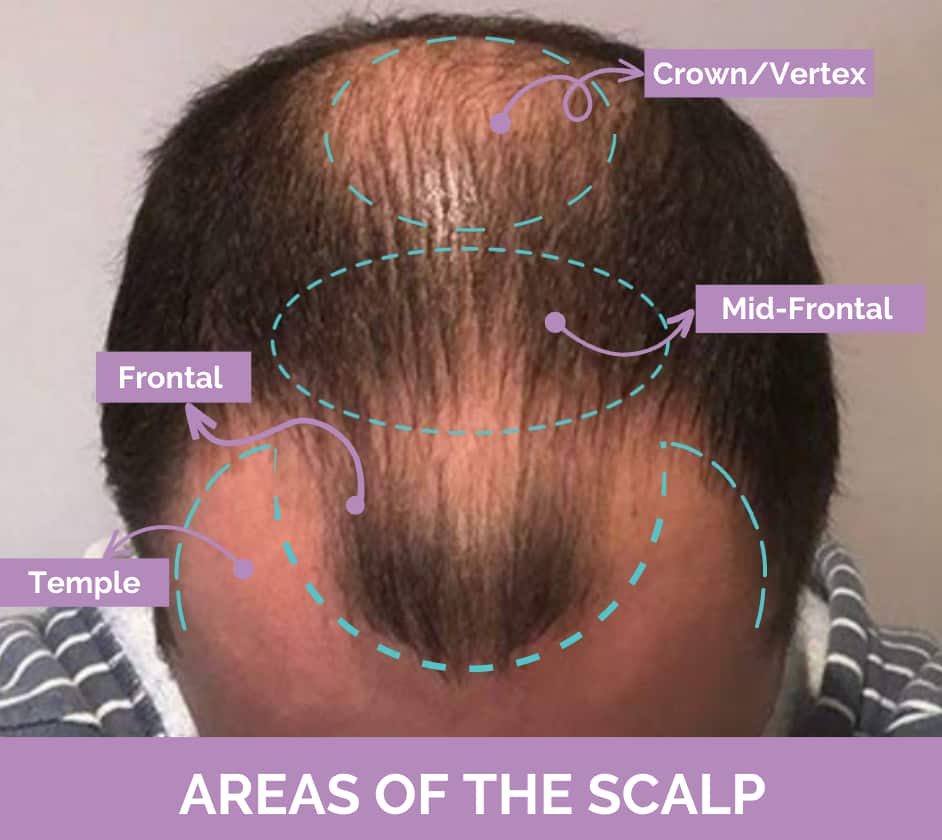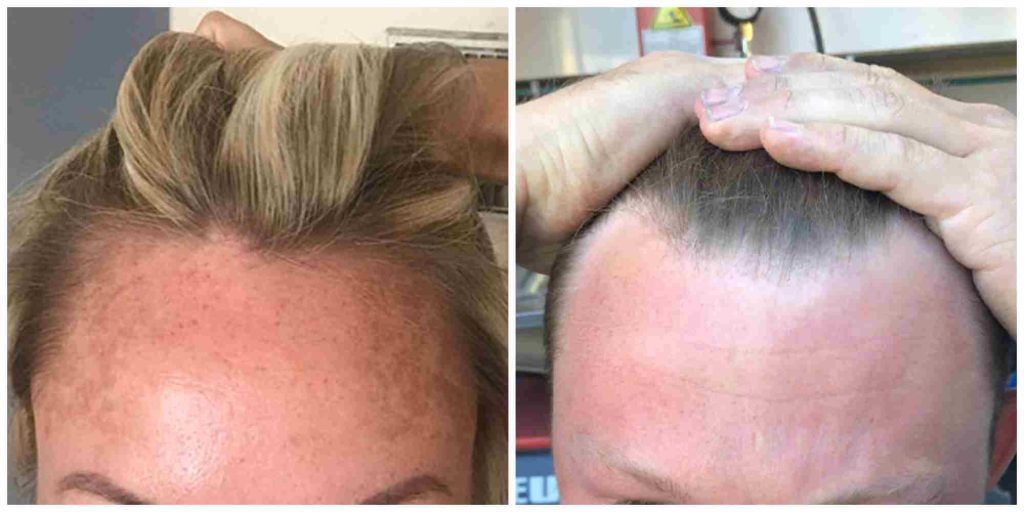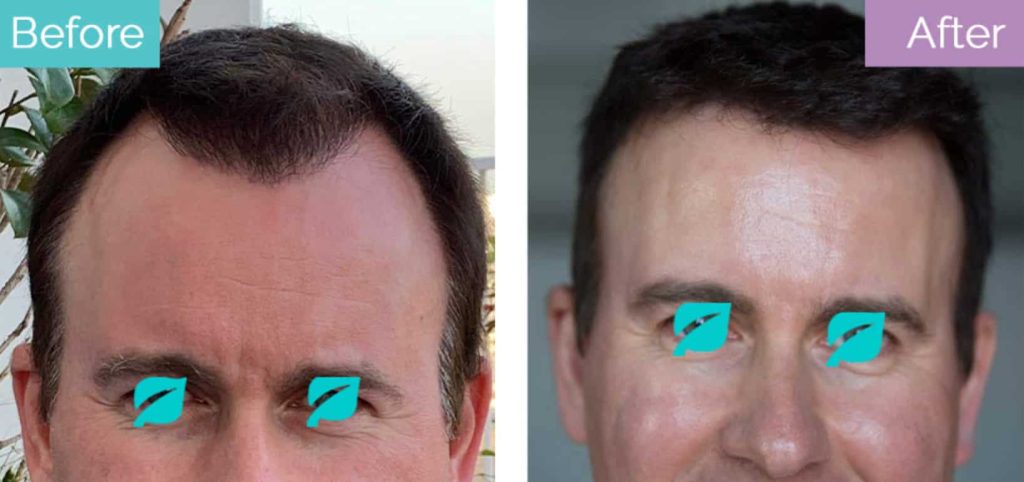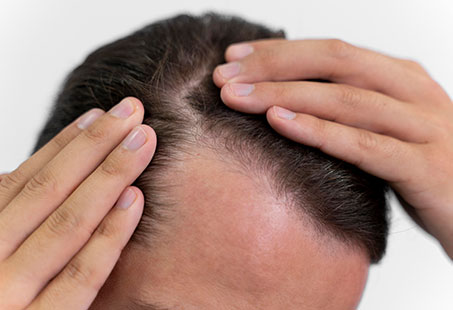People often experience hair loss around their temples. And there are many reasons why that can happen.
It doesn’t always happen in isolation, though. Temple hair loss can be accompanied by hair loss in other areas of the scalp as well.
It can be concerning in any case, especially since the temples cannot be easily hidden. So, in this guide, you’ll find everything you need to know about temple hair loss.
Where’s The Temple Area Of The Scalp?
The temple area is the area on the side of the head above the ears and between the eyes and the forehead.

It should be noted that, in general, the density of the hair in the temples is lower. In addition, the shaft of the hair is also thinner.
For this reason, if you lose your temple hair, it will be quickly more noticeable than hair loss in other areas of the scalp.
What Causes Temple Hair Loss?
Most commonly, temple hair loss occurs due to androgenetic alopecia. As per the Norwood Scale, hair loss in men begins around the temples and crown. In women, however, hair loss is usually diffuse, but some cases involve receding temple hair.
According to a study published in Advances in Dermatology and Allergology, women have 2 to 5 times more aromatase enzyme (converts androgens to oestrogen) in their scalp, especially in the front. This may be a reason why they don’t lose as much hair there as men, who have lower levels of the same enzyme.
However, pattern baldness isn’t the only cause of temple hair loss. It can also occur due to:
- Traction Alopecia – Tight hairstyles (high ponytail, braids, cornrows, dreadlocks) can especially cause bald spots in the temple areas.
- Telogen Effluvium – Resulting from physical or emotional stress, telogen effluvium can also cause thinning of the temples. According to research in the Journal of Clinical and Aesthetic Dermatology, telogen effluvium usually affects the temple regions.
- PCOS – Polycystic ovary syndrome usually causes hair loss around the temples, along with the front of the scalp.
- Trichotillomania – This hair-pulling disorder can also leave a bald patch in one (or both) of the temples.
- Frontal Fibrosing Alopecia – Commonly affecting women, it can be another cause of temple hair loss.
- Illness – Infections (ringworm), autoimmune diseases (lupus, alopecia areata), skin problems (seborrheic dermatitis) and hormonal imbalances (thyroid) can all lead to thinning of the temples.
- Central Centrifugal Cicatricial Alopecia – While it commonly affects the central or crown region of the scalp, it can also cause hair loss in the temples.
- Triangular Alopecia – Believed to run in families, congenital triangular alopecia also causes hair loss at the front and temporal regions of the scalp.
- Medication – Certain medications can cause hair loss, and they can cause thinning along the temples.
- Malnutrition – Without proper nutrition, you will lose hair, which can also make the temple hair look thinner.

Temple hair loss can be caused by a number of factors at the same time. For an accurate diagnosis, it’s important that you seek the advice of a medical professional.
How To Stop Hair Loss At Temples?
Treatment for temple hair loss depends on the cause. If you’re losing temple hair due to androgenetic alopecia, you might be recommended minoxidil, finasteride, and/or spironolactone.
However, these drugs only give results as long you’re on them, and they can cause unpleasant side effects.
Laser hair growth therapy and platelet-rich plasma injections can also help you. But if you’re seeking a permanent solution, you may be advised to have a transplantation surgery.

For other types of hair loss, you might also be prescribed a corticosteroid or an immunosuppressant.
Some people also try home remedies (onion juice, green tea, aloe vera, etc.) to stop temple hair loss. However, they don’t have enough scientific backing and might not work.
You may lose valuable time in getting early treatment if you try these before seeking professional advice.
Can Temple Hair Regrow?
Temple hair can regrow if the hair loss is temporary. However, you’ll have to change your hair care and styling habits. For instance, if your temples are thinning due to tight hairstyles, you need to start wearing your hair loose.
On the other hand, if the temple hair loss is permanent, certain medications can help with temporary regrowth. But once you discontinue them, you’ll lose the hair once more.
How To Hide Temple Hair Loss?
You can hide your temple hair loss with a permanent scalp tattoo (scalp micropigmentation). Even though it’s at the front of the scalp, you can get natural results with the right practitioner.
Other than that, you can try a hair topper, wig or clip-in extensions to hide the bald spots in the temple(s). You can also accessorise with beanies, caps, headbands, and scarves to hide the front of your scalp.
Bangs are another obvious way in which you can hide temple hair loss. Additionally, you should consider wearing hairstyles that don’t involve a side part.
Lastly, you can also use hair fibres. However, its results can be very cosmetically unappealing because these fibres can take on a greenish hue.
How To Prevent Temple Hair Loss?
It’s not always possible to prevent hair loss on the temple (like in androgenetic alopecia). But it is definitely avoidable in some cases. So, you may be able to prevent it by doing the following:
- Do not tie your hair too tightly.
- Look for ways to manage and reduce stress.
- Eat healthy foods.
- Have a healthy lifestyle.
- Be gentle with your hair, and don’t use a lot of harsh products and tools.
These things can help you keep your temple hair intact.
Conclusion
In general, temple hair is frail and less dense. So, when you lose it, you’re likely to notice it even more than usual.
Usually, temple hair loss is a result of androgenetic alopecia. However, it can also occur due to a variety of other factors. It can be either temporary or permanent, and it might not always be possible to reverse it.
In any case, it’s important for you to consult with a medical professional. They’ll create a treatment plan for you based on your needs.


